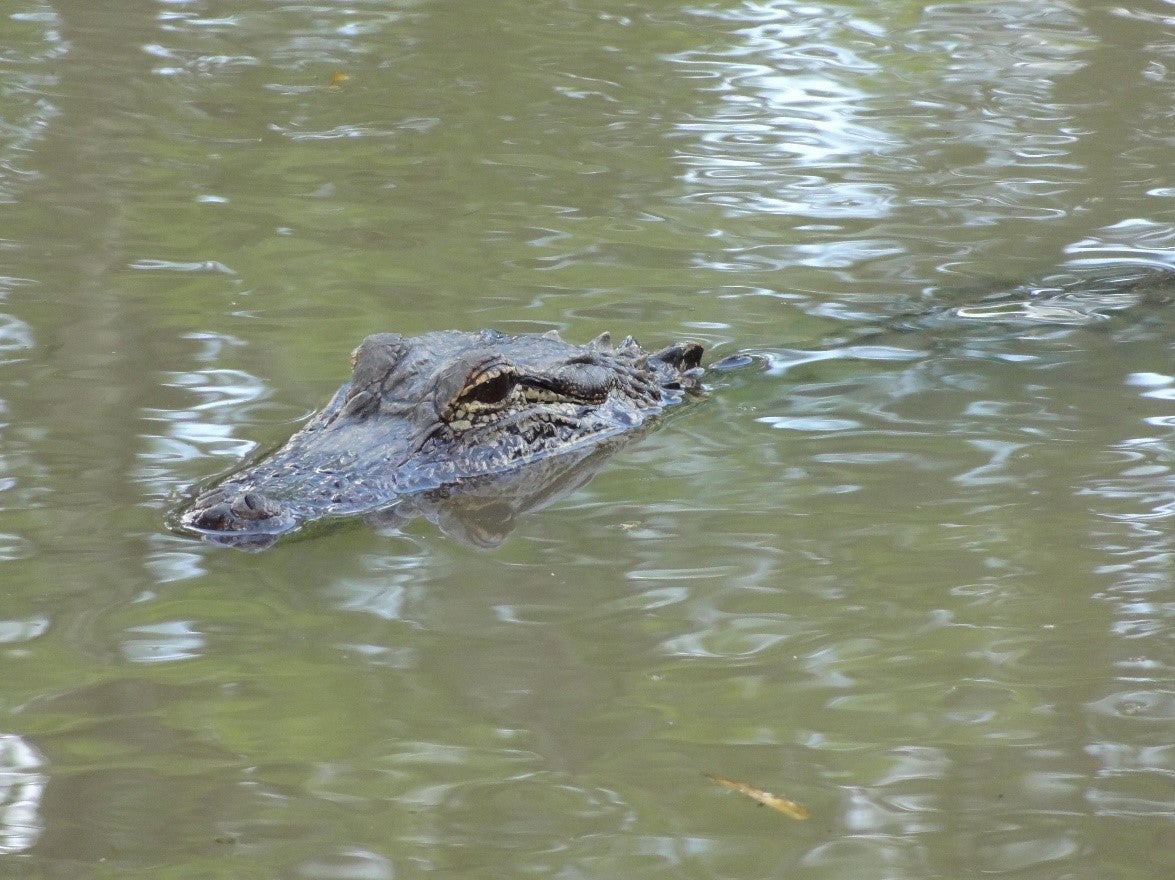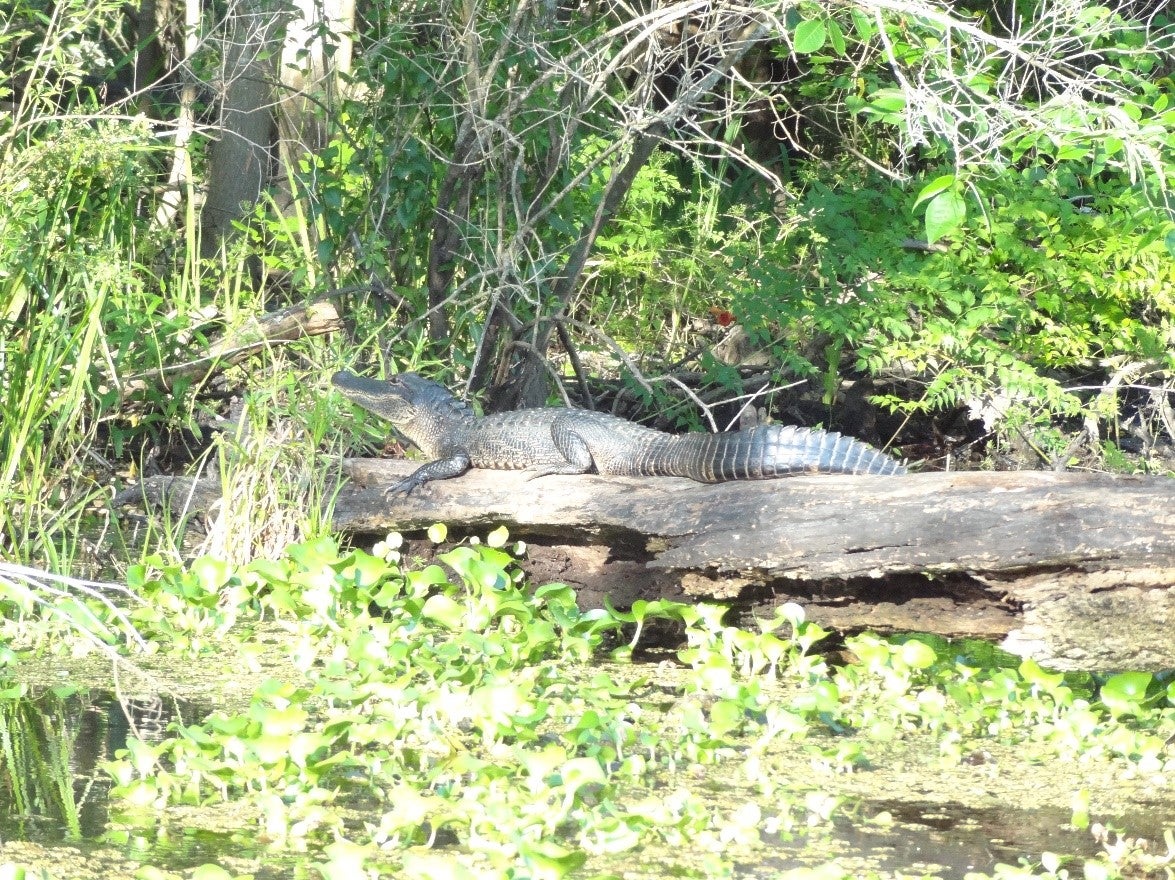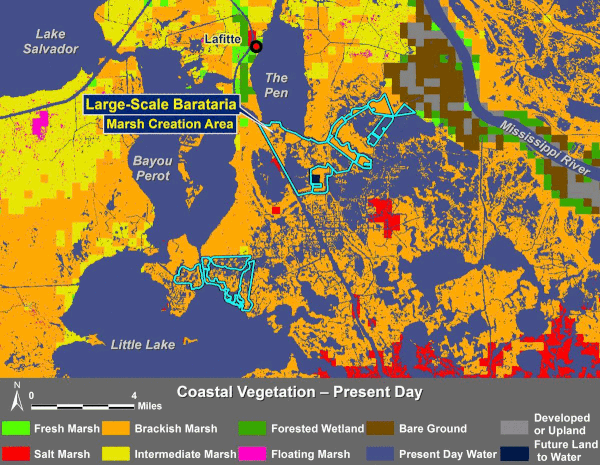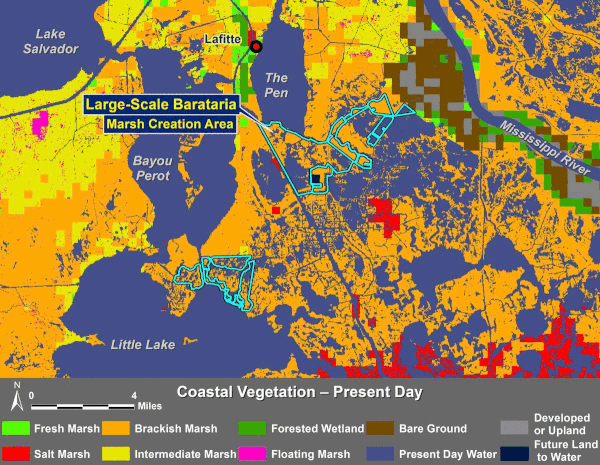Strategic Marsh Creation Can Make a Big Difference in the Barataria Basin
To restore Louisiana’s coast, we need a suite of large-scale restoration projects across the coast working together to deliver maximum benefits to reduce land loss, restore ecosystems, and maintain healthy and diverse habitat. In our “Restoration Project Highlights” series, we take a deeper look at specific projects from our list of Priority Projects, highlighting why they’re needed and hearing local perspectives on importance.
*THIS BLOG WAS UPDATED ON 06/28/2022 TO REFLECT CURRENT PROJECT STATUS
Why is the Large-Scale Barataria Marsh Creation Project Important?
In the middle of the Barataria Basin there is a ribbon of wetlands stretching from the Mississippi River levee to the community of Lafitte. These wetlands make up the Barataria Landbridge and are incredibly valuable to nearby communities and wildlife. The landbridge helps separate saltwater and brackish marshes in the lower part of the basin from the freshwater and intermediate marshes and swamps in the upper basin. In doing so, the landbridge protects these upper basin wetlands from saltwater intrusion and erosion, preventing them from becoming open water. The community of Lafitte and other nearby communities need these wetlands as a vital buffer and line of defense from storm surge and tidal flooding, and they provide important habitat for an abundance of wildlife and fish.
Unfortunately, canals, erosion and subsidence have led to significant land loss in this area. Continued disintegration of the landbridge will leave freshwater wetlands in the upper basin exposed to saltwater intrusion and increased wave action, leading to their loss.The 2017 Coastal Master Plan (CMP) includes a project that would prevent this terrible scenario from occurring. It is the Large-Scale Barataria Marsh Creation Project – a 12,900 acre coastal restoration project that would create new marsh habitat and restore degraded marshes on the landbridge. This project will use dredged sediment to rebuild and restore marshes in this area.
A local’s take on the Large-Scale Barataria Marsh Creation Project
Wildlife Needs this Project
The Barataria Landbridge helps maintain a range of salinities and a diversity of wetland habitat – from bottomland hardwood swamps to saltwater marshes – that allow a variety of fish and wildlife species in the Barataria Basin to not just survive, but thrive! Louisiana’s coastal crisis is not just about losing land, but it’s about the type of land we’re losing. To maintain our status as sportsman’s paradise and ensure we’re providing a diversity of habitat for all species to exist and thrive, we need to maintain that full estuarine gradient that supports species from freshwater to saltwater habitat and everything in between!
This restoration project would help protect the National Park Service’s Jean Lafitte Barataria Preserve, which encompasses 23,000 acres of swamps, marsh and waterways and is home to armadillos, swamp rabbits, white-tailed deer, several different species of bats, and tree frogs. In addition, a huge variety of birds (including the ) use the park’s waterways and wetlands for foraging, resting and nesting habitat.
 |
 |
While the preserve is home to a lot of wildlife, the species that gets the most attention from the park’s many visitors is the American alligator. In warmer months, visitors exploring the preserve’s trails can often see alligators in the canals or sunning themselves along the banks of waterways. Once nearing the brink of extinction, conservation and management efforts have allowed the alligators to rebound. The Barataria Landbridge helps protect this national resource from saltwater intrusion, preventing the devastating loss of the park’s freshwater wetlands that fish and wildlife, like the American alligator, need to thrive.
What Does a Future Without Action Look Like?
Future with action assumes all projects in the 2017 Coastal Master Plan are operating.
What does a future without action look like? |
What does a future with action look like? |
 |
 |
Progress on Large-Scale Barataria Marsh Creation
The Large-Scale Barataria Marsh Creation project is estimated to create and restore 12,900 acres of wetlands and has a cost of approximately $674,500,000. Given the scale and complexity of the project, it includes multiple components and is being implemented at different stages. Since 2010, approximately 1,700 acres of marsh have been created or nourished within the project footprint, including three phases of the Bayou Dupont Project (BA-39, BA-164, BA-48) and the Mississippi River Long Distance Sediment Pipeline (BA-43-EB). Other components of the Large-Scale Barataria Marsh Creation project are also moving forward. The Northwest Turtle Bay Marsh Creation project (BA-125) completed construction in 2021 and will create and nourish approximately 760 acres of marsh. There are also two projects that are currently in construction, the Northeast Turtle Bay Marsh Creation (BA-206) which would create and nourish approximately 677 acres of marsh and an increment of the Large-Scale Barataria Marsh Creation Project (BA-207), which started mobilizing in December 2021 and is anticipated to be completed in early 2024. BA-207 will build 882 acres of marsh. This project, along with the Mid-Barataria Sediment Diversion, are being considered for this funding source because the marsh creation project can build land quickly and the input of sediment and freshwater from the diversion can help sustain the marsh creation project, as well as build new land over the long term.
Be a voice of support for this critical restoration project! Sign up here:
Sign up here to stay updated on this project and to hear about opportunities to advocate for its completion.
